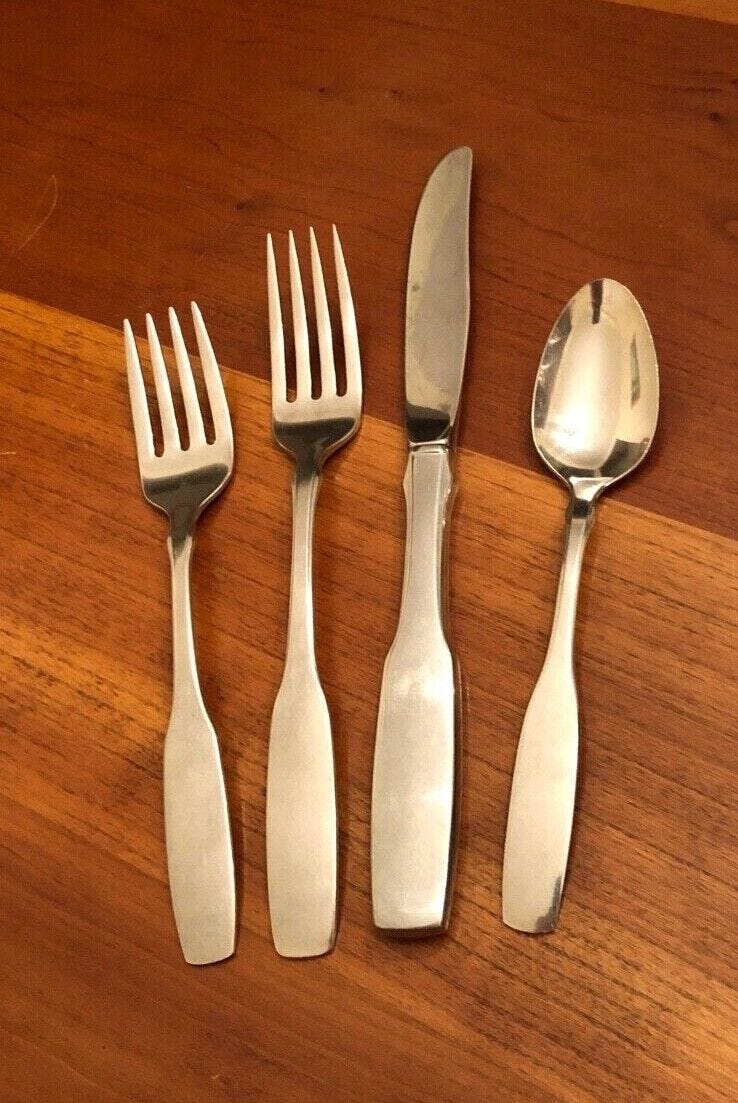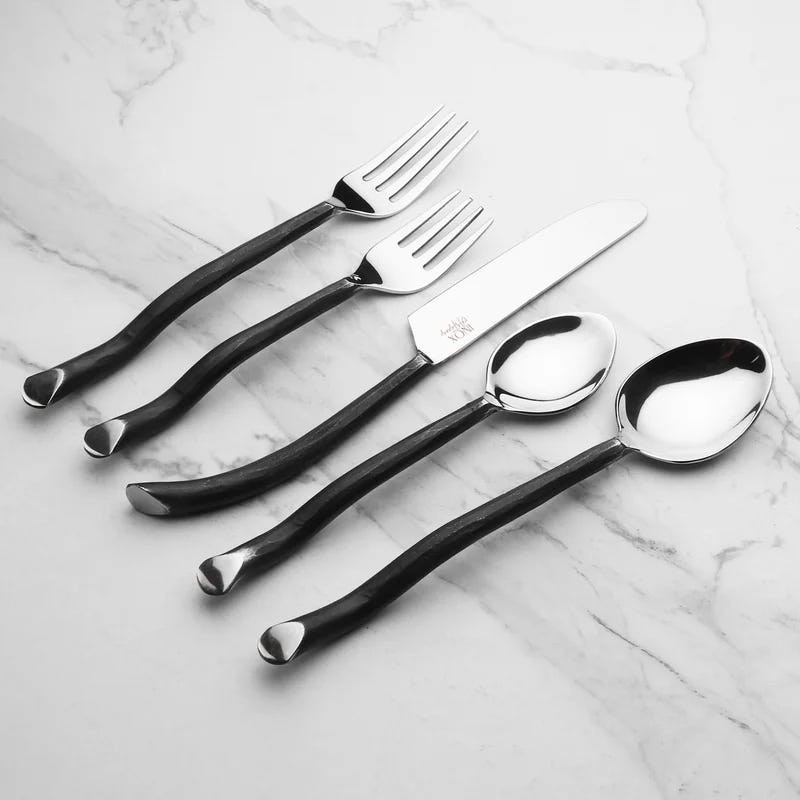Somatic Experience > Aesthetics
insights from searching for the perfect silverware
In need of silverware for our new cabin, I browse designs online for hours, disliking all of them.
It dawns on me: I’m nearly 40 and I have not yet found silverware better than my parents'. Every other utensil I have used is a subtle disappointment. Too chintzy, too heavy, too uncomfortable, too shiny.
Is it that the set that I grew up with is canonical in my mind because I grew up with it, or is there something else to the design?
Exasperated, I pick out a contemporary silverware set from my sea of tabs and tell myself, “This one. This will be fine. They’re just utensils.”
But there's something wrong with the design, I know. I just can’t put my finger on it.
I call my mom.
"It's nice," she agrees. "But I worry it's not weighted well and the rigid edges won't feel comfortable."
Ah, there it is. I've been looking at aesthetics, but it's the somatic I’m after: I've been using my eyes when what has been whispering in me is the sense of holding it, the fork becoming an effortless extension of my hand.
I recall a review on one set:
"We bought these for a party and the fork kept slipping out of everyone's hands. I've never heard so many fork drops in one night. Only the dog was delighted."
When I read the review I thought it was silly, but now I understand the issue: the weighting of the fork was wrong, causing people to drop it. I think of the awkward weighting of my AirPods—one part heavy and one part featherweight—and how I drop them constantly.
I recall my somatic memory of using my parents' silverware, the fork resting effortlessly in my hand. It's that perfect weighting that I've been searching for.
I look up my parents' set. It was designed in 1959 (!), and named Paul Revere after the revolutionary who was a renowned silversmith whose shop created over 2,400 pieces of silverware between 1761 and 1797.
I’m not the only person who appreciated the design: while exact numbers aren’t published, the long production run suggests millions of pieces of Paul Revere silverware have been sold over the decades. Oneida’s stainless utensils, especially patterns like Paul Revere and Twin Star, dominated the mid-century market. By some accounts, Paul Revere place settings were extremely common on American dinner tables by the 1970s.
I wonder how it is that we have not developed a better design for utensils since 1959. (Certainly someone must have, but I have not found it.)
I blame computers:
In the 1700s, Paul Revere himself would have designed, handcrafted, and held the piece, all in one go. He would get feedback on his design quickly.
In the 1950s, designers would have sketched out their designs and then developed a prototype directly in metal to test the weight, balance, and feel.
Nowadays, designers work first in CAD, then have a model 3D printed, and then finally a metal prototype might be created. No wonder designers are having difficulty getting the weight right! They’re trying to design without feeling.
Meanwhile, buyers are buying without feeling. In the past we would have gone to a store and picked up the utensils. But now that most of physical stores have closed, we shop online.
Online, our only clues are photos, description, and price. Scrolling through a sea of photos, our eyes fatigue quickly looking at similar-looking sets. Glazing over slight variations in styles, our eyes perk up when they see something unique. "Ah yes, I want silverware with handles shaped like twigs. How cool, what a statement."
But... is that what we really want?
Is silverware a design statement about your aesthetic preference specialness, or is it a tool for everyday life whose ergonomics are of utmost importance? We are, after all, using these items three times a day! Doesn't our experience of being a body using these tools matter most?
I recall a review of another set:
"Really beautiful set. But the small fork only has three prongs and it doesn't hold spaghetti well."
YOU HAD ONE JOB, FORK. And yet the designer dropped a prong so that the set would be pretty.
Our values are all wrong.
I don't want utensil-as-concept. I don't want a fork cutely pretending to be a twig. I want a tool that is saturated in its essence. I want the genuine thing, not a trend.
I want a fork because I want food to go into my mouth, not an accessory to show off to others. Who cares what other people might think for a quarter second, I am using this thing three times a day, 365 days a year, to EAT.
The final issue is our concept of price and value. Another reviewer says:
“I love the set—it seems more expensive than it really is!”
Really, that’s why you love it?
My parents have had their set for 45 years, and Oneida continues to offer a limited lifetime guarantee. What does another $40 matter if spread out over the course of 50 years?
But then again, maybe modern sets won't last that long. A reviewer of a supposedly high-quality German set complained the set started to rust after six months.
I think of the last set that I bought. It was a bit pricey, and I assumed that meant quality. The design was attractive, but the utensils turned out to be light and cheap-feeling. The manufacturer had sold me on a premium trend, not a timeless set. How was I to know the difference without being able to feel it in person?
I complain about all of this to my mom, who listens patiently.
"Well you can still buy the set we have. They still make it."
In this moment I accept defeat. I have been trying all my adult life to find silverware better than my parents', and I have not.
Despite economic stresses and bankruptcy of the original company, the Paul Revere line has never been out of print since 1959. I go to buy the new production of the set, but the reviews complain it's not quite the same as the original. Classic.
So I shell out $150 for a 47-piece set on eBay. It is scratched and worn. I imagine that likely it is from someone who has passed—who else would give it up?
I hope it will last me the rest of my life. And then who knows, maybe it will go to someone else who finally sees through trends to find the real thing.
My partner Jesse had a similar experience with drinking glasses. He grew up with a few glasses of a particular design and liked them. Never finding better glasses, he started buying them on eBay and at thrift stores.
When I first see the glasses, I balk at their old-fashioned look. But then I use one. And it's the same thing as with the silverware: the weighting. The base is a bit heavy; it feels good in your hand. And somehow it holds the perfect amount. It's human-centric.
Eventually my eyes catch up to my somatic knowing. Instead of seeing the glasses as granny, I see them as perfection—a classic standard unsurpassed in somatic experience.
Are we doomed to only buy increasingly rare vintage items designed before computers? I hope not. I hope designers will wake up and design things using all their senses for the experience of the human body, and that individuals will buy things for their full experience and not just for how something appears on a screen.








this was so fun to read, and also i love how you and jesse are both design nerds in the best way
Hehe, this resonates so much. When I bought my current cutlery set 14 years ago, which was the first time I didn't just buy the cheapest cutlery I could find at IKEA, I very deliberately bought a high quality variation of my favorite cutlery set from my parents.
A very minimalistic, classic design with a lot of attention to ergonomics. It still feels beautiful, and most importantly, great to use all these years later.